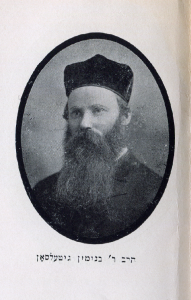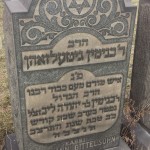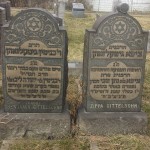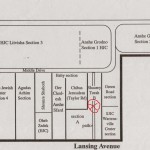Rabbi Binyamin Gittelsohn
בנימין ב"ר יהודה ליב
Chief Rabbi, Cleveland, OhioDate of Death:
Fri. January 1, 1932 -
Teves 22 5692
Anyone with biographical information is asked to please send it in.
See CONTACT page for details. Thank you.
Directions to Kever: Lansing Cemetery Association in Cleveland, Ohio maintains computerized records and will provide a detailed location map upon request. Location: See map below.
Name Listed on Cemetery Database: Name listed on marker: Rabbi Benjamin Gittelsohn
Biographical Notes:

Photo Caption: Rabbi Binyamin Gittelsohn, Source: J.D. Eisenstein

Credit: Institute For Judaic Culture and History IFJCAH
Bio Information:
Rav Gittelsohn was born in Lithuania (1851-1853), son of Rav Yehuda Leib a descendant of Rav Yeshaya Halevi Horowitz, Shelah Hakadosh. The Rav’s father passed away when he was eight. Impoverished, he wandered from town to town for charitable donations enabling him to receive a traditional yeshiva education. Rav Gittelsohn attended the yeshiva of Slabodka and thereafter Slonim where he was ordained. The Rav’s first rabbinical post was in Alanta and soon after, Troskunai, a small Lithuanian town. He remained very poor, because the Jewish community was unable to pay an adequate salary. In 1890, the Rav was asked to settle in Cleveland by the growing community of Lithuanian Jews in the city. After serving various congregations throughout the city he was appointed as the Moreh Dasrah of Oer Chodosh Anshe Sfard where he remained until his passing. As Cleveland’s first rabbinic scholar he was led to become the spiritual authority for many of the surrounding congregations.
Rav Gittelsohn published two seforim (books) Ha-Poteah ve-ha-Hotem (New York, 1898) and Seder Haggada shel Pesah ‘im Be’ur Nagid ve-Nafik (Jerusalem, 1904). Additionally, he wrote a commentary on Tefilah (prayer) that was never published. The Rav married Celia “Sippa” Alenik while still in Lithuania, they had 12 children.
(Based on information obtained from The Encyclopedia of Cleveland History)
« Previous: Rabbi Yosef Zelig WeismanNext: Rabbi Tzadok Bailey »





Rabbi Gittelson was an early member of the Agudath Harabonim.
His safer:
http://hebrewbooks.org/pdfpager.aspx?req=2336&pgnum=1
Row B-3 (north) (From JewishGen)
Still no photo of the kever?
Here is another sefer from the Rav:
http://www.hebrewbooks.org/pdfpager.aspx?req=4974&st=&pgnum=1&hilite=
Yahrzeit 22 Teves 5692 – Jan 1 1932
Source: Jowbr
is anyone aware where his writings that arent in a YU ended up?
The Rav’s complete peirush on the Hagada was just published and I heard its amazing. Any idea where to find it and who did the job?
בין המון הגדות הנדפסים בכל שנה ושנה נפלו עיני להגדש”פ ע”פ נגיד ונפיק שנדפסה זה עכשיו מחדש ע”י מו”ה שלום זשייקאב ממונסי הי”ו תלמידו של הגרי”ד שלעזינגער שליט”א.
הגדה זו נדפסה לראשונה בירושלים לפני מאה ועשר שנים בשנת תרס”ד ונתחברה ע”י אחד מגאוני וגדולי ישראל שחיו חיי מרורים על אדמת אמעריקא וכמעט שנשכח זכרו, ה”ה הגאון רבי בנימין גיטעלזאהן זצ”ל אב”ד קליוולאנד בעמח”ס הפותח והחותם ושא”ס.
רבי בנימין נפטר בשנת תרצ”ב ונטמן בקליוולאנד, מצבתו עדיין לא נצתלמה ולא בא זכרו באתר קברים, גם לתמונה מהרב לא זכינו עדיין, ואולי יש מחברינו פה דרך למצוא פרטים עליו.
למה בחר הרב זשייקאב להדפיס את ספרו לא יודע אנכי, ההגדה נתעטר בהסכמת הג”ר שמואל עקיבא יפה-של”ז משטראסבורג אבי הגרי”ד שליט”א.
בפתיחת הספר יש קוים קצרים לתולדותיו אבל לא עשה עבודת מחקר כראוי וכיאות לגאון הנשכח כמותו.
http://www.ivelt.com/forum/viewtopic.php?p=838178#p838178
http://rabbibenjamingittelsohn.blogspot.com/
To Levi, very interesting, where can I get the new hagodo?
It was printed by R’ Shalom Jacob in Monsey NY
914-260-1112
He did a nice job!
He considered himself “Rav of Cleveland.” That’s how he signed his name in a Haskama to a sefer written by my alte zaide in 1903.
GITTELSON, BENJAMIN (1853-1 Jan. 1932), rabbi and scholar, was born in Lithuania, son of Judah Leib Gittelson. He was descended from a long line of rabbis, but fatherless and impoverished, he wandered from town to town for charitable donations enabling him to receive a traditional yeshiva education. He became rabbi of Avanta in 1878, leaving in 1883 to become rabbi of Trashkun. He remained very poor, because the Jewish community was unable to pay an adequate salary. In 1890, Gittelson was asked to settle in Cleveland by the growing community of Lithuanian Jews in the city, becoming rabbi at Beth Hamidrosh Hagodol, serving that congregation until 1901. He then assumed the pulpit of Oer Chodosh Anshe Sfard and remained its rabbi until his death. Gittelson was a quiet, learned man who eschewed an active communal role among Cleveland’s Orthodox Jews. However, his religious knowledge as Cleveland’s first rabbinic scholar led him to become the spiritual authority for other small congregations, among these Ohave Emuna Anshe Russia, Shaari Torah, and Agudath Achim. Gittelson provided the community with responsa and discourses on Jewish law and custom. He published 2 scholarly works: Ha-Poteah ve-ha-Hotem (New York, 1898), a collection of Talmudic discourses, many given before Cleveland congregations; and Seder Haggada shel Pesah ‘im Be’ur Nagid ve-Nafik (Jerusalem, 1904), a detailed commentary on the Passover Haggadah. Additionally, he wrote a commentary on the prayerbook that was never published. Gittelson married Celia “Sippa” Alenik while still in Lithuania. They had 12 children: Louis, Abraham David, Reuben, Rachel (Klein), Rose, Lena, Albert, Minnie (Broida), Jack, Nathan, Sarah, and Rebecca. He is buried in Cleveland’s Lansing Cemetery.
Source: Case Western Reserve University
I would love to see more pictures of him does anyone have any and I would love to speak with a descendant please call 347 765 4319 with info